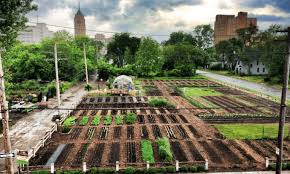Exploring the Benefits of Urban Agriculture Products
Urban agriculture products are gaining popularity as more people become interested in sustainable living and local food production. From rooftop gardens to community allotments, urban areas are increasingly becoming hubs for growing fresh produce. Let’s delve into the benefits of these products and how they contribute to healthier cities.
Fresh and Nutrient-Rich Produce
One of the primary advantages of urban agriculture products is the freshness of the produce. By growing fruits, vegetables, and herbs locally, consumers can enjoy food that is harvested at its peak ripeness, retaining maximum nutrients and flavour.
Reduced Food Miles and Carbon Footprint
By cultivating food within city limits, urban agriculture helps reduce the distance that produce needs to travel from farm to table. This not only lowers carbon emissions associated with transportation but also supports a more sustainable food system.
Community Engagement and Social Cohesion
Urban agriculture projects often bring communities together, fostering a sense of shared purpose and connection among residents. Whether through communal gardens or farmers’ markets, these initiatives promote social interaction and strengthen community bonds.
Green Spaces in Urban Environments
Integrating agriculture into urban landscapes helps create green spaces that improve air quality, provide habitats for wildlife, and enhance overall aesthetics. Rooftop gardens, vertical farms, and urban orchards contribute to a greener and more sustainable cityscape.
Food Security and Resilience
Urban agriculture can play a crucial role in enhancing food security by diversifying local food sources and reducing reliance on imported goods. In times of crisis or supply chain disruptions, having access to locally grown produce can bolster a city’s resilience against external shocks.
In Conclusion
Urban agriculture products offer a multitude of benefits that extend beyond individual health to encompass environmental sustainability, community well-being, and urban resilience. As cities continue to embrace these initiatives, they pave the way for a more vibrant, healthy, and interconnected urban future.
Six Essential Tips for Successful Urban Agriculture: Cultivating Greens and Community in the City
- Choose suitable plants for urban environments, such as herbs, leafy greens, and small fruits.
- Utilize vertical space by growing plants on walls or trellises to maximise limited space.
- Consider using self-watering containers or drip irrigation systems to efficiently water your crops.
- Use organic fertilisers and pesticides to promote healthy growth without harmful chemicals.
- Regularly monitor sunlight exposure to ensure your plants receive adequate light for photosynthesis.
- Engage with the local community by sharing surplus produce or organising workshops on urban farming.
Choose suitable plants for urban environments, such as herbs, leafy greens, and small fruits.
When engaging in urban agriculture, it is essential to select plants that are well-suited to the constraints of city environments. Opting for herbs, leafy greens, and small fruits is a wise choice as these plants tend to thrive in urban settings with limited space and sunlight. By choosing suitable plants for urban agriculture, such as these versatile options, individuals can maximise their yield potential and enjoy a bountiful harvest even in the midst of a bustling cityscape.
Utilize vertical space by growing plants on walls or trellises to maximise limited space.
To maximise limited space in urban environments, a valuable tip for urban agriculture products is to utilise vertical space effectively. By growing plants on walls or trellises, individuals can optimise their growing area and cultivate a variety of crops even in confined spaces. This innovative approach not only enhances productivity but also adds a visually appealing element to urban landscapes, transforming unused walls into vibrant green spaces that contribute to the overall sustainability and beauty of the city.
Consider using self-watering containers or drip irrigation systems to efficiently water your crops.
When cultivating urban agriculture products, it is advisable to explore efficient watering methods such as self-watering containers or drip irrigation systems. These innovative techniques help maintain optimal soil moisture levels, reduce water wastage, and promote healthier plant growth. By incorporating such sustainable practices into your urban farming endeavours, you can enhance crop yield while conserving valuable resources for a more eco-friendly and productive gardening experience.
Use organic fertilisers and pesticides to promote healthy growth without harmful chemicals.
Using organic fertilisers and pesticides in urban agriculture products is a sustainable practice that promotes healthy growth without the use of harmful chemicals. By opting for natural alternatives, such as compost, manure, or bio-based pest control methods, urban farmers can nurture their crops while safeguarding the environment and public health. Organic solutions not only support the vitality of plants but also contribute to the overall well-being of urban ecosystems, ensuring that fresh produce cultivated in city settings is safe, nutritious, and environmentally friendly.
Regularly monitor sunlight exposure to ensure your plants receive adequate light for photosynthesis.
To maximise the growth and health of your urban agriculture products, it is essential to regularly monitor sunlight exposure. Ensuring that your plants receive adequate light for photosynthesis is crucial for their overall development. By paying attention to sunlight levels and adjusting the positioning of your plants accordingly, you can help them thrive and produce quality produce in your urban setting.
Engage with the local community by sharing surplus produce or organising workshops on urban farming.
To maximise the impact of urban agriculture products, it is essential to engage with the local community by sharing surplus produce or organising workshops on urban farming. By sharing excess harvests with neighbours or setting up educational sessions on sustainable growing practices, individuals can foster a sense of community spirit and knowledge exchange. These initiatives not only promote a culture of sharing and cooperation but also empower residents to actively participate in shaping a greener and more resilient urban environment.
